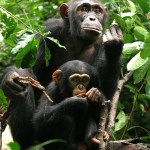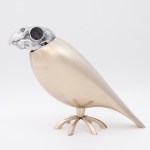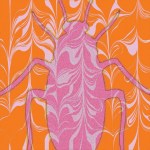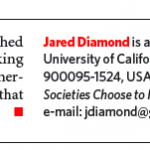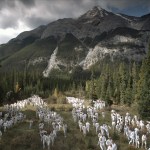biology
Culture defines who we are but few can explain where it comes from or why we adopt one tradition over another. In the classic musical The Fiddler on the Roof the main character, Tevye, muses on this basic fact of human existence:
Here in Anatevka we have traditions for everything... how to eat, how to sleep, even, how to wear clothes. For instance, we always keep our heads covered and always wear a little prayer shawl... This shows our constant devotion to God. You may ask, how did this tradition start? I'll tell you - I don't know.
The origin of particular cultural traits in human…
"Companion Parrot": An incredible, though slightly macabre, necklace of bird entrails and skull by Tithi Kutchamuch. When not being worn, the necklace rests in the minimalist golden body, and it's a sculpture.
Via Haute Macabre
A short, wordless film inspired by numbers, geometry and nature, and created by Cristóbal Vila. Thanks to reader Esmeralda for passing this one along!
tags: Life, Discovery Channel, Reptiles and Amphibians, Waterfall Toad Leap from Danger, animals, mammals, birds, BBC, television, streaming video
Gail Weiswasser at the Discovery channel emailed a few days ago to tell me about TONIGHT's premiere on the Discovery Channel of BBC's LIFE, the 11-part follow up to PLANET EARTH (the most successful natural history documentary of all time). While PLANET EARTH told the story of the natural world through the framework of our planet's ecosystems and regions, LIFE takes us on a more intimate journey, introducing different animal and plant groups, using…
A few thoughts on this ad I spotted last week in Boston:
1. Yes, that appears to be a giant gel electrophoresis. Geez, this town is nerdy.
2. I hope that attractive woman is supposed to be a genetics PhD. Because we're all supermodels.
3. Why didn't I ever think to do a random restriction digest and blot on my own DNA back when I was in the lab 18 hours a day, so I could false-color it in Photoshop, hang it above the mantel, and brag about my trendy home decor? Bah! I suppose maybe there were rules about that sort of thing.
4. The loft development website asks, "What's your design DNA"?…
Artist S. Shelley Jones sent me a link to some digital art depicting the lowly cockroach, who turns out to be much more attractive with a psychedelic spin. Thanks, Shelley!
PS. "The Psychedelic Cockroach" is a great band name, isn't it?
top: Cockroach No. V, 2009; bottom: Cockroach No. VII, 2009; by S. Shelley Jones.
While I was on blogcation, I got an email from the watchdog group Stinky Journalism, complaining that prominent science author and professor Jared Diamond (Collapse, Guns, Germs and Steel) was in the hot seat again. (You may remember that Stinky Journalism broke the story about the lawsuit against Diamond arising from his New Yorker piece on tribal violence in New Guinea; I blogged about the fallout of the controversy here and here.)
Really? I thought; what has Diamond supposedly done this time? Here's the scoop from Stinky Journalism:
[In] the February 18 issue of the journal Nature . . .…
The Science of Reading is the Harvard library's nice new site about reading. Lots of great old texts and some history of reading science.
BBC News - Man assaulted female police officer with penis. The court heard he had been drinking heavily and could not remember committing the offence at his home in Aberdeen
Â
Â
Â
Indiana Jones & the Ants - The New York Review of Books
In her review of Harvard entomologist E.O. Wilson's first novel, Anthill, in the April 8 issue of The New York Review, Margaret Atwood encourages anyone interested in ants to "take a…
Won't the dismal, subdued palette of winter release its hold on you? Never fear, a stripe of spring magenta is approaching! This infographic by Fernanda Viagas and Martin Wattenberg of HINT.fm depicts the dominant colors in flickr photographs of Boston Common around the year, starting with summer at the top:
It makes me wonder what similar graphics would look like for other geographic regions - or even for flickr photos in general across continents or hemispheres. Would seasonal trends be detectable? Do we compensate for the dismal palette outside by photographing lots of technicolor…
Ok, so we all know this is a wasp. But what's with the lumps near the tip of the abdomen?
Ten points for identifying the lump, and five points for anyone ambitious enough to put a name on the wasp, too.
Image: The Daffodil Cichlid of Lake Tanganyika / Koen Eeckhoudt
In 1888 "Darwin's Bulldog", Thomas Henry Huxley, declared that nature was little more than a "gladiator's show" whereby only "the strongest, the swiftest, and the cunningest live to fight another day." Brutal competition was the only important factor in the natural world, in which a "Hobbesian war of each against all was the normal state of existence." As such, we shouldn't expect cooperation in nature because only strength and selfishness is rewarded by evolution.
But a paper by Dik Heg and colleagues, entitled Helpful Female…
One of my pet peeves is the idea that BMI provides an accurate indication of individual health. It doesn't. It's useful across populations (and may be useful to individuals to monitor progress), but when it comes to indicating which individuals are "healthier", BMI fails miserably - and our new Sciblings at Obesity Panacea do a great job of explaining why.
If, as a policy matter, we want to differentiate between the healthy and unhealthy - which is a big if, depending on how libertarian you are - let's make such assessments meaningfully, using a workout that proves general endurance and…
Only National Geographic would dare cross The Amazing Race with the mystery of conception to get. . . The Great Sperm Race:
Each of us was the grand prize in an ultimate reality competition, the amazing race a sperm makes on the road to fertilization. Millions of sperm compete while overcoming armies of antibodies, treacherous terrain and impossible odds to reach their single-minded goal. To illustrate the full weight of the challenge, Sizing Up Sperm uses real people to represent 250 million sperm on their marathon quest to be first to reach a single egg.
Obviously there aren't 250 million…
tags: evolution, evolutionary biology, gynandromorph, bilateral gynandromorph bird, half-sider, mixed-sex chimaera, sex determination, molecular biology, genetics, developmental biology, endocrinology, birds, chicken, Gallus gallus, ornithology, researchblogging.org,peer-reviewed research, peer-reviewed paper, journal club
Half-sider.
Almost exactly one year ago, hundreds of American birders
were thrilled by sightings and photographs of this remarkable
Northern Cardinal, or Redbird, Cardinalis cardinalis,
photographed in Warrenton, VA.
Image: DW Maiden, 2 March 2009.
I'll never forget…
I remember Craig Venter talking about synthetic life in the fall of 2007 with Carl Zimmer. Last summer he said that we'd have the first "synthetic species" by the end of the year. I haven't heard about it in 2010, have you? Anyone have info on what's going on here? No surprise that project deadlines get pushed back, it happens. But it seems like I've been hearing "wait 6 months" since the beginning of 2008. Does it actually work out so that only God can pull this off? Or is this vaporscience (OK, he got the genome part nailed down, but that was a while ago)?
I've written before about a recent whale vertebra that someone had dropped into a lake far from the sea in northern Sweden. This past summer, fishermen trawling off the country's southern coast caught two old whale bones, and they've turned out to belong to a grey whale, a species that's been extinct in the Atlantic since the 17th century. An unidentified whale beached itself and died in the area in 1709. Radiocarbon will tell if the newly found bones are likely to belong to that animal.
[More blog entries about whales, balticsea, Sweden; valar, Ãstersjön, Ystad.]
tags: evolution, evolutionary biology, ancient DNA, aDNA, molecular biology, molecular ecology, archaeology, paleontology, fossil eggshell, extinct birds, giant moa, Dinornis robustus, elephant birds, Aepyornis maximus, Mullerornis, Thunderbirds, Genyornis, researchblogging.org,peer-reviewed research, peer-reviewed paper, journal club
Elephant bird, Aepyornis maximus, egg
compared to a human hand with a hummingbird egg balanced on a fingertip.
To conduct my avian research, I've isolated and sequenced DNA from a variety of specimens, such as blood, muscle, skin and a variety of internal…
At the time I photographed this little scene (at Bell Smith Springs, Illinois) I was myself unsure of the drama playing out on the oak gall. I sent pictures to wasp expert Hege VÃ¥rdal to see if my preliminary guess of a pair of gall parasites was worth anything. Her reply:
I believe that you are on the correct track concerning the specimens. It is probably an inquiline and a parasitoid trying to reach the gall chamber. It looks like a unilocular (one-chambered) gall. Often the inquiline female kills the gall wasp larva when ovipositing in the gall or alternatively the inquiline larva kills…
Why do I think that this will end badly? From the UK:
Japanese knotweed was first introduced as an ornamental plant in the 19th Century. But with no natural enemies in the UK it soon raged out of control, wiping out surrounding wildlife and even destroying buildings. The invasive species, that can grow up to 13ft tall and break through concrete, causes around £150 million worth of damage every year.
Gardeners tried starving it of water, soaking it in toxic weedkiller and simply just ripping it up, but nothing worked - until now.
A tiny insect called a psyllid, about the size of a grain of…
I can't say I disagree with these pro-octopus sentiments, though having a cheap and charismatic supergenius escape artist does not preclude having a panda too:
Washington needs a new animal celebrity, one more in line with our character, intellect, values and personality. We need to love and celebrate an animal that is more than a bamboo-eating ball of fur. We must end our cuteness dependence on China, for crying out loud.
Helloooo, giant Pacific octopus.
No, really, it makes perfect sense. â¦
When it feeds, it often slowly descends onto a coral, ballooning around it, then devouring any of…
